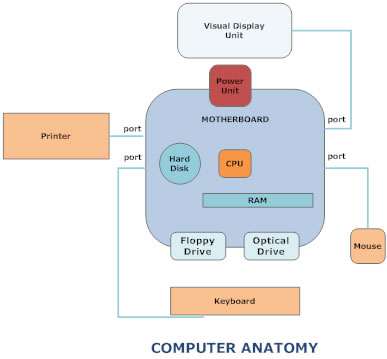 Section
Navigation
Section
Navigation
7. Technical Aspects
:Fundamental
7.1 Anatomy of Internet
7.2
Telecommunications
7.3 Wireless systems
7.4 Client Computers
7.5
Mobile Devices
7.6 Operating Systems
7.7 Computer Programs
7.8
Security: Applications
7.9 Browsers
7.10 Business Intelligence Systems
7.11 Cloud Computing
7.12
Databases
7.13 DTP Programs
7.14
eBook Readers
7.15 eMail Services
7.16 Expert Systems
7.17
Graphics Programs
7.18 Internet TV
7.19 Music & Video
7.20
Really Simple Syndication
7.21 Rich Media
7.22 Search Engines
7.23
Spreadsheets
7.24 Video Conferencing
7.25 Word Processing
:Corporate
Matters
7.26 Cluster Analysis
7.27 Neural Networks
7.28
Pricing Models
7.29 Realtime Systems
7.30 Regression Analysis
 7.4
Client Computers: Definition
7.4
Client Computers: Definition
Client computers are simply those operated by the 'end-user' of the client-server system of the Internet, i.e. employed by individuals browsing the Internet, sending email messages, etc.

Anatomy
The control unit of a computer is the central processing unit (CPU) mounted on a motherboard, which contains slots for memory modules (RAM: random access memory) and various expansion cards. Also integral is a hard disk (a series of revolving fragile magnetic platters that store tiny bits of magnetic metal in patterns that it can read later), an optical drive that reads and writes to a CD, a floppy drive, ports from which cables attach to peripherals and USB socket(s) for a pendrive (flash memory) and other devices. The whole is powered by a power unit, which transforms the mains high voltage alternating current to low voltage direct current. Peripherals include a video display unit (VDU: formerly a cathode ray tube but generally now a flat, liquid crystal display screen), a mouse or tablet, and keyboard. The operating system ( basic software) allows peripherals to operate with each other, and client applications to be run. The usual operating systems are Windows, Mac, Unix and Linux.
Maintenance
Computers in larger companies are usually networked and managed by the IT Division, which is responsible for maintaining the trouble-free running of the system and its security. A firewall protects the system from unshielded Internet access, and there may also be anti-virus and anti-spyware programs periodically run to remove unwanted snippets of code that can compromise security. The IT Department is also responsible for granting access privileges, making continual backups of information, and strict rules as to what employees can and cannot do on the client computers. Client computers are commonly simple terminals with limited individual processing power, a trend increased with cloud computing services.
Computers are simple units, but need to kept clean, serviced periodically, clutter removed from hard disks, software updated, passwords stored safely and data backed up regularly. The most important of these are data backup and password safety.
Smaller companies are often given this advice:
All that's needed by the average small company is a little forethought, some inexpensive software, mandatory routines and a plan to meet eventualities. Suppose a spyware program steals your passwords, or customer are bombarded with third-party credit card details? Perhaps the office burns down, or you hosting company suddenly goes out of business? However rarely, all these things do happen. Draw up a contingency plan, circulate it, make sure it really works and that staff know what to do.
Office Security Routines
The following are obvious but can be overlooked:
1. Use
hard-to-guess passwords, restrict access to them, and don't leave them in desk
drawers or on PCs.
2. Ensure backups are made regularly, in sequence, and
are intelligently labeled.
3. Check backups regularly, i.e. ensure that restores
from backups are sound.
4. Keep paper copies, and in a safe place.
5.
Store copies of all essential information, preferable encrypted and off-site:
in CDs, removable hard-disks, pendrives, and/or with professional data storage
companies.
Protection from Viruses
Do the following:
1. Consider using alternative browser(s).
2. Get the appropriate
virus protection software, and keep it up to date.
3. Install a firewall.
4. Set passwords properly on networks ( IT manager's job).
Protection from Spyware
Many computers are infected by spyware of some sort. Most are 'harmless', but an increasing number pass into viruses that will steal and transmit confidential information, even memorizing the keystrokes of passwords. You need to:
1. Avoid keeping confidential information on any
machine connected to the Internet.
2. Run spyware removal software.
3.
Encrypt confidential information.
4. Consider purchasing a special guide to
spyware.
5. Visit security sites for information on the latest threats.
Protection from Hackers
Hackers break into computer systems, sometimes to prove themselves, sometimes with malicious intent. You need to:
1. Install
a firewall.
2. Ensure sensitive information is encrypted.
3. Maintain
proper security (restrict access with passwords) in the office.
 Questions
Questions
1. Describe the main components of a Personal Computer and explain how
they operate.
2. What backup routines would you impose, and why?
3.
How do viruses differ from spyware, and how can you minimize the risk they represent?
 Sources
and Further Reading
Sources
and Further Reading
1. Anatomy of a computer. Gcts.
Simple pictures.
2. Computer Anatomy: What Is Inside That Beige Box?
by James Cox. Melbourne
PC user Group. More detailed but non-technical account.
3. Basic Pc
Anatomy. Bucarotechelp.
Breakdown of computer units: a little more technical.
4. Computer.
Wikipedia.
More technical account, providing history, basic functioning and links to more
specialized accounts.
5.
About Internet Security. About's usual good advice and listings.
6. AntiOnline.
Extensive information, discussion forum and live chat on Internet security.
7. Internet Fraud Watch.
Provides free articles, advice and bulletins on anti-fraud measures useful to
emerchants
8. Internet
ScamBusters. Scams to watch out for: not specifically ecommerce.
9. National Consumer
League. Many useful tips on minimizing fraud.
10. National
Security Institute. Alerts, government standards and articles (dry
but authoritative).
11. SecurityFocus.
Articles on all aspects of Internet security, sometimes rather technical.
12. Security Magazine.
News, product reviews and free magazine to professionals.
13. Wilder's
Security Forums. Grouped under threat and software.